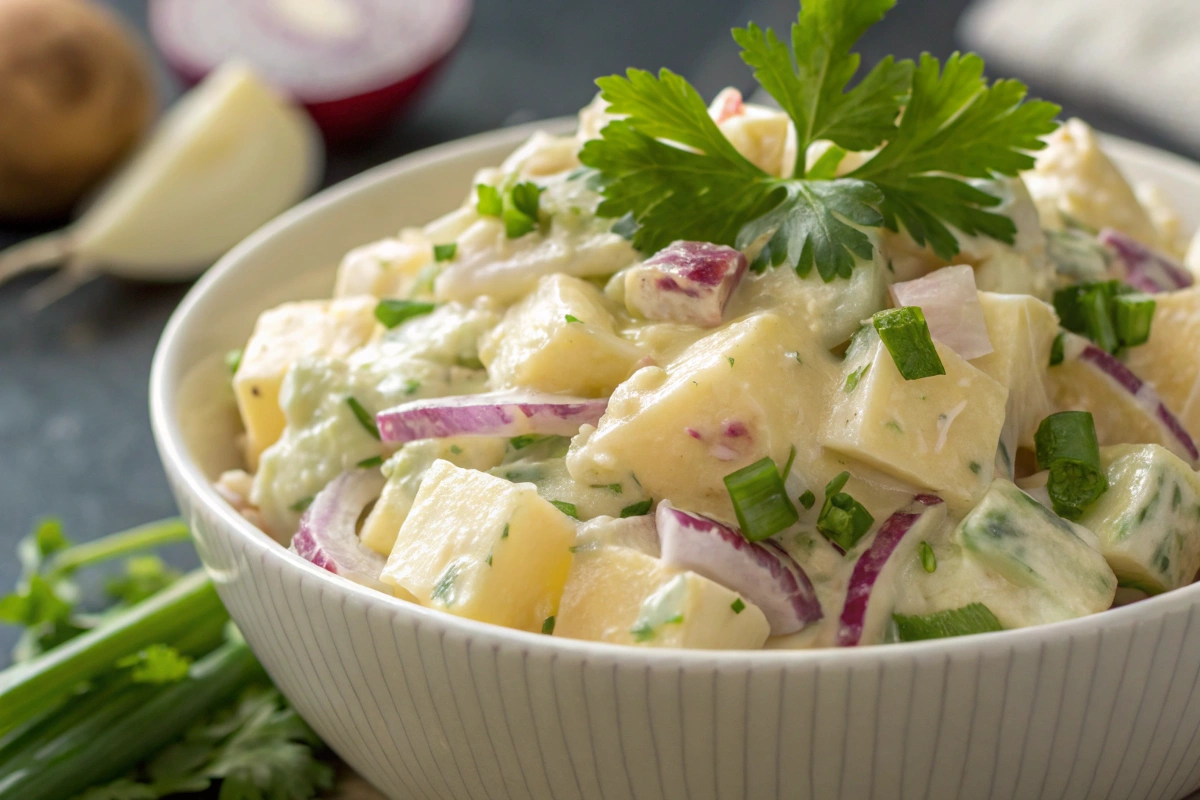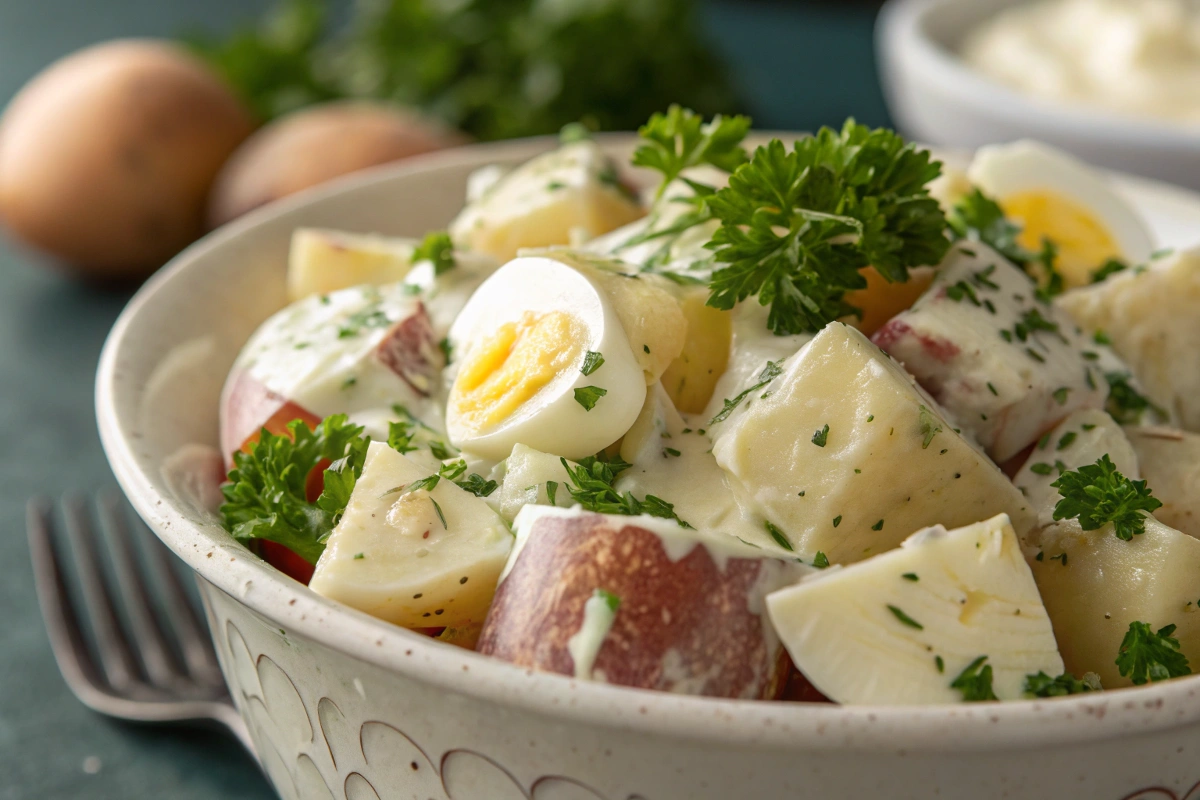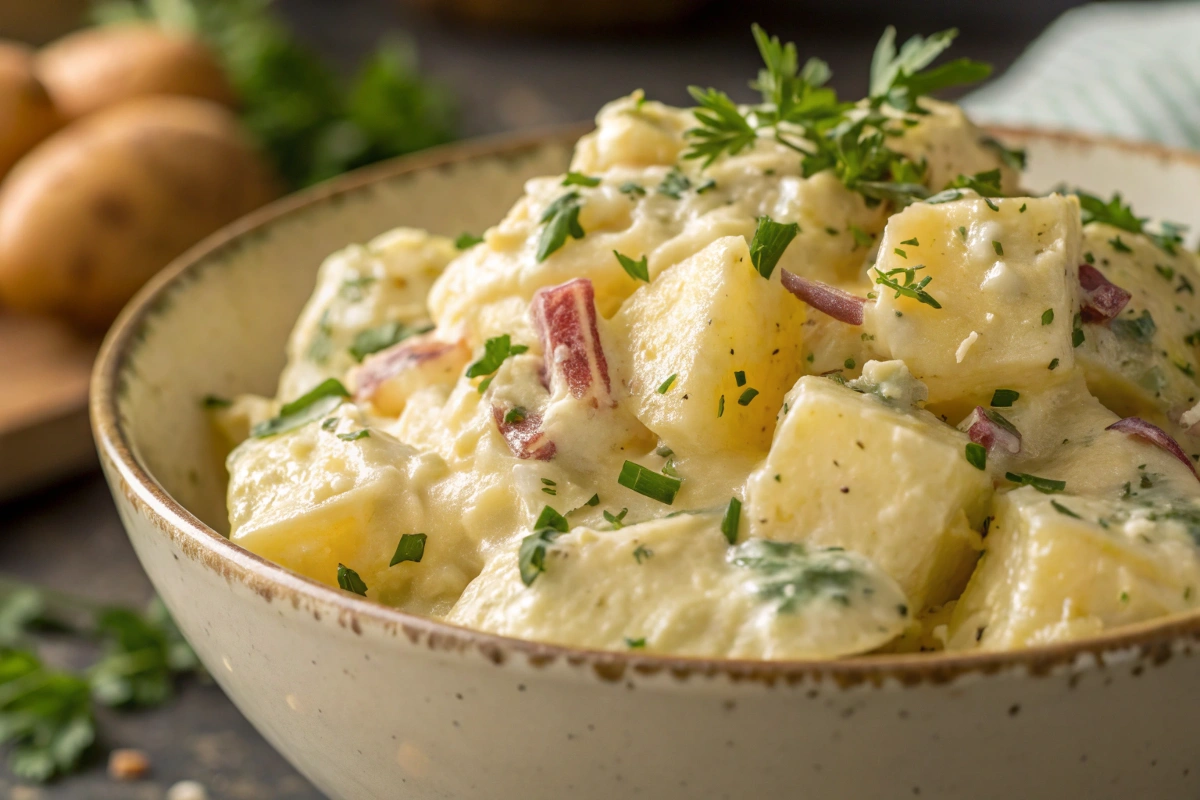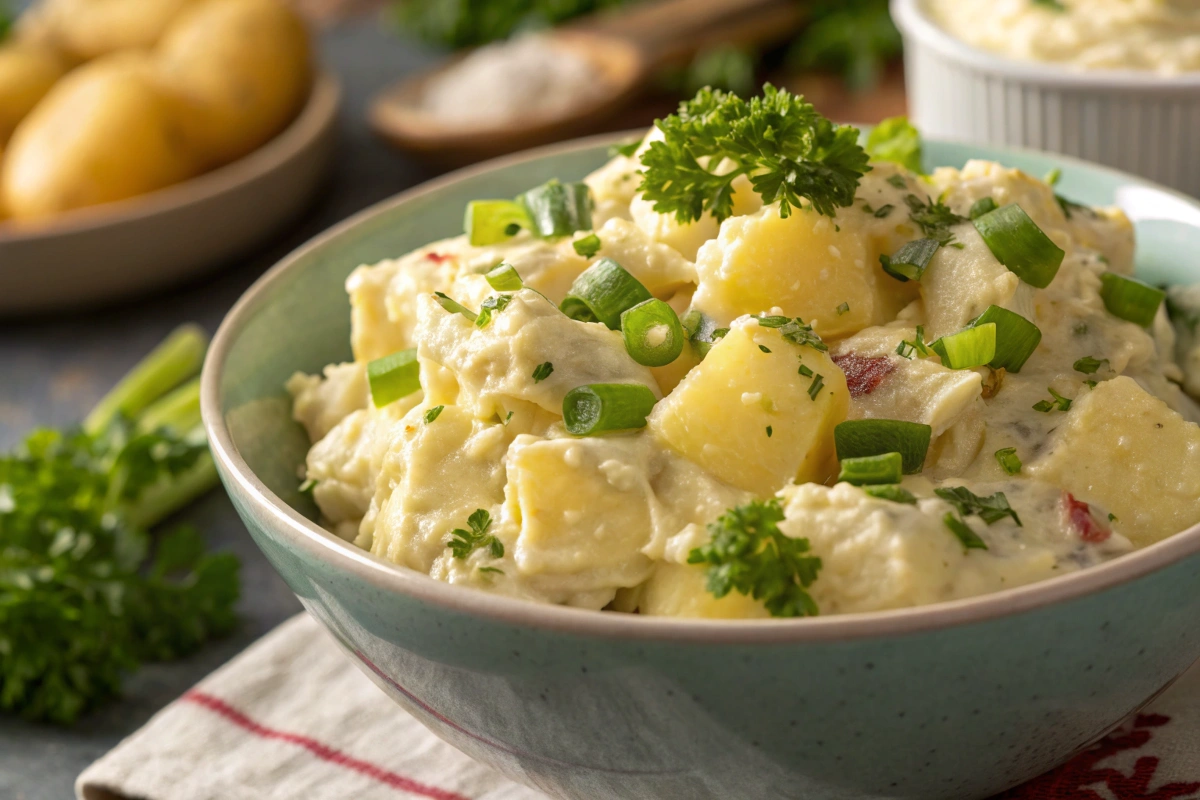Potato salad is a favorite side dish, but what if you make too much and don’t want to waste it? Can you freeze potato salad? The answer is yes, but it’s not as simple as freezing other foods. Freezing can affect the texture, flavor, and consistency due to the ingredients like potatoes and mayonnaise.
While freezing is possible, it may change the dish’s quality. If you decide to freeze potato salad, use proper techniques to minimize these changes. Keep realistic expectations, and follow tips for thawing and refreshing it later.
1. Potato Salad?
Potato salad is a classic dish made from boiled potatoes mixed with various ingredients such as mayonnaise, mustard, onions, celery, and sometimes hard-boiled eggs or pickles. It’s typically served cold, making it a popular side dish for barbecues, picnics, or holiday gatherings. The flavors can be customized to suit different tastes, with options for creamy, tangy, or even spicy variations.
2. Why Freezing Potato Salad Can Be Helpful
For many, freezing potato salad is a practical way to handle surplus portions or save time in the kitchen. While fresh potato salad is undoubtedly best, freezing offers some undeniable advantages that make it a tempting option for home cooks. Let’s explore why freezing potato salad appeals to so many people:
- Preventing Food Waste
One of the biggest reasons people consider freezing potato salad is to avoid wasting leftovers. Potato salad is often prepared in large quantities, whether for family gatherings, picnics, or barbecues. After the event, you might find yourself with more salad than you can reasonably eat before it spoils. Instead of tossing it, freezing becomes an appealing way to preserve what’s left. - Convenience
Freezing potato salad allows for advanced meal prep. If you’re hosting a party or preparing for a busy week, freezing lets you make large batches ahead of time. Simply thaw it when needed, and you’ve saved yourself time and stress on the day of the event. - Budget-Friendly
Making potato salad from scratch can involve a variety of ingredients, from high-quality potatoes to specialty dressings. Throwing away leftovers feels like throwing money down the drain. Freezing offers a way to stretch your food budget further by preserving leftovers or repurposing them for another occasion.
However, freezing potato salad isn’t always the best choice. Some types of potato salad don’t freeze well due to their ingredients, while others might lose their appeal after thawing. By understanding how freezing impacts the dish, you can decide whether it’s a worthwhile solution for your specific situation.

3. What Happens to Potato Salad When Frozen
To understand why freezing potato salad can be tricky, it’s helpful to look at the science behind how freezing affects its key ingredients. Each component—potatoes, mayonnaise, and seasonings—responds differently to freezing, which ultimately impacts the dish’s overall quality.
Impact on Potatoes
Potatoes are a fundamental ingredient in potato salad, but they’re not particularly freezer-friendly. Potatoes have a high water content, which poses challenges during freezing and thawing. When frozen, the water inside the potatoes forms ice crystals. These crystals can rupture the cell walls, causing the potatoes to lose their firm, creamy texture. Once thawed, the potatoes may feel grainy, mushy, or slightly watery.
The type of potato used also matters. Waxy potatoes like red or Yukon Gold varieties tend to hold their shape better than starchy potatoes like Russets. Even so, freezing significantly alters their texture, and they may not retain the same pleasant mouthfeel you’d expect from freshly prepared potato salad.
How Dressings React to Freezing
Mayonnaise is a common ingredient in many potato salad recipes, but it’s one of the most challenging components to freeze. Mayonnaise is an emulsion of oil, egg yolks, and vinegar or lemon juice. When frozen, the fat and water components in mayonnaise tend to separate. Upon thawing, the dressing can become watery, oily, or curdled, significantly impacting the salad’s consistency and appeal.
Similarly, dairy-based dressings like sour cream or yogurt may also undergo separation during freezing. These ingredients lose their smooth, creamy texture, often leaving a grainy or lumpy residue when thawed. This is why creamy potato salads are generally considered less freezer-friendly than their vinegar-based counterparts.

Changes in Flavor and Texture
Beyond the individual ingredients, freezing also alters the texture and flavor of the entire dish. Potato salad relies on a delicate balance of creamy, tangy, and savory elements. Freezing dulls these flavors, leaving the salad tasting flat or muted. Ingredients like onions or celery, which add crunch and freshness, can lose their crispness, resulting in a less appealing texture.
In short, freezing potato salad is a trade-off. While you can preserve it for future use, the texture and flavor will almost certainly be affected. However, with proper techniques, you can minimize these changes and enjoy a reasonably good version of your salad after thawing.
Summary of Key Points
- Potatoes become grainy or mushy due to ice crystals breaking down their structure.
- Mayonnaise and dairy-based dressings separate, altering the consistency.
- Flavor and texture are often less vibrant and cohesive after freezing.
By understanding these effects, you’ll be better equipped to make an informed decision about whether freezing potato salad is the right solution for you., with ingredients like onions, celery, or eggs becoming soggy or rubbery.
4. Different Types of Potato Salad and Freezing Results
When it comes to freezing potato salad, not all versions are created equal. The type of potato salad you’re dealing with—whether creamy, vinegar-based, store-bought, or homemade—plays a significant role in how well it holds up in the freezer. Some types freeze better than others, and understanding these differences can help you decide whether freezing is worth it.
Creamy Versions: Challenges of Mayo-Based Salads
Mayo-based potato salads are the most challenging to freeze due to their creamy dressing. Mayonnaise is an emulsion made of oil, egg yolks, and an acid like vinegar or lemon juice. Unfortunately, freezing disrupts this delicate balance. When frozen, the fat and water in mayonnaise separate, leading to a watery, oily, or curdled texture upon thawing.
Beyond the dressing, the potatoes in mayo-based salads also face challenges. As they thaw, they may absorb excess water from the separated mayonnaise, resulting in a mushy and unappealing texture. Additionally, ingredients like celery or onions can lose their crunch, further diminishing the salad’s overall quality.
That said, freezing mayo-based potato salad isn’t impossible—it just requires extra effort to restore its consistency after thawing. For instance, you can remove excess mayonnaise before freezing and add fresh mayo or sour cream once thawed to refresh the salad. However, keep in mind that the texture and flavor may not match the original.
Vinegar-Based Salads: A Freezer-Friendly Option
Vinegar-based potato salads, such as German potato salad, are much better suited for freezing. These salads typically omit mayonnaise and instead use a dressing made from vinegar, oil, mustard, or broth. Because these ingredients are less prone to separation, the dressing maintains its consistency even after freezing.
Additionally, vinegar-based potato salads often feature sturdier potatoes like red or waxy varieties, which hold their shape better than starchy options like Russets. This means the texture is more likely to remain intact, even after freezing and thawing.
Another advantage of vinegar-based salads is that their tangy flavor profile holds up well to freezing. The acidity of the vinegar acts as a natural preservative, ensuring the salad tastes fresh and vibrant after thawing. If you’re considering freezing potato salad, vinegar-based recipes are your best bet for preserving quality.

Store-Bought vs. Homemade: What Freezes Better?
Store-bought potato salads often contain stabilizers and preservatives designed to extend shelf life, which can also make them more freezer-friendly. These additives help prevent separation and texture changes, meaning store-bought versions may fare better in the freezer than homemade ones.
On the other hand, homemade potato salads usually lack these stabilizers, making them more susceptible to changes during freezing and thawing. However, homemade salads allow for greater control over the ingredients. For example, you can choose a vinegar-based dressing or use waxy potatoes to improve their freezability.
Whether store-bought or homemade, the key to successful freezing lies in proper preparation. Removing excess dressing and freezing in airtight containers can help preserve the salad’s quality, regardless of its origin.
5. Steps for Freezing Potato Salad the Right Way
If you’ve decided to freeze potato salad, following the correct steps can significantly improve the outcome. Freezing potato salad requires careful preparation and attention to detail to minimize texture and flavor changes. Here’s how to do it right:
Step 1: Preparing Your Salad for Freezing
- Remove Excess Dressing: Creamy dressings like mayonnaise are prone to separation during freezing. To reduce this effect, remove some of the dressing before freezing. Adding fresh dressing after thawing can help restore the salad’s original consistency.
- Cool Completely: Make sure the potato salad has cooled entirely before freezing. Allowing it to sit at room temperature and then refrigerating ensures no condensation forms, which could create unwanted ice crystals.
Step 2: Choosing Storage Containers That Work
- Airtight Containers: Freezer-safe containers with tight-fitting lids work best to prevent air from entering and causing freezer burn.
- Freezer Bags: These are another excellent choice for storing frozen potato salad. Remove as much air as possible before sealing to protect the salad’s quality.
- Portion Control: Dividing the salad into smaller portions is a smart way to thaw only what you need, reducing unnecessary waste.
Step 3: Freezing Tips to Keep Quality Intact
- Flash Freezing: If possible, flash freeze the potato salad. Spread it out in a thin layer on a baking sheet and place it in the freezer until solid. Once frozen, transfer the salad to containers or bags. This method helps preserve texture and prevents clumping.
- Leave Space for Expansion: Liquid components in the salad may expand during freezing. Leave a bit of space in the container to accommodate this expansion.
- Freeze Promptly: Don’t leave potato salad at room temperature for extended periods before freezing. Bacteria can grow quickly in the “danger zone” between 40°F and 140°F, so freeze the salad as soon as it’s prepped.
6. Proper Thawing and Serving Tips
Thawing frozen potato salad correctly is just as important as freezing it properly. Done incorrectly, it can result in soggy potatoes, separated dressing, and a disappointing dish. Follow these steps to ensure the best quality:
How to Thaw Safely
- Refrigerate Overnight: The safest method is to move the frozen salad from the freezer to the fridge. Let it thaw slowly overnight to help retain its texture and flavor. For more ideas on handling freezer-friendly foods, explore our guide on freeze-dried bananas for long-lasting snacks.
- Avoid Room Temperature Thawing: Never leave potato salad out on the countertop to thaw. This practice increases the risk of bacterial growth, which can make the salad unsafe to consume.
Reviving Your Potato Salad After Thawing
- Add Fresh Dressing: If the dressing separates or loses its consistency, stir in fresh mayonnaise, sour cream, or a vinegar-based option to bring back its creaminess. Pairing it with dishes like Lipton Onion Soup Meatloaf can elevate your meal further.
- Mix Carefully: Use a spatula to fold the ingredients gently, preventing further breakdown of the potatoes and other components.
- Enhance the Taste: Since thawing can dull flavors, brighten the salad with a pinch of salt, pepper, or fresh herbs like parsley or dill. For more savory pairings, consider recipes like baked chicken cutlet recipes to complete your meal.
By following these steps, you’ll have a dish that’s close to its original quality. Although it might not match the freshness of a newly made salad, proper thawing and refreshing techniques make it satisfying enough to enjoy.

7. Common Questions About Freezing Potato Salad
Is it possible to freeze potato salad with mayonnaise?
Yes, but mayonnaise doesn’t freeze well. The fat and water in mayonnaise tend to separate, leading to a watery or oily consistency. To minimize this, remove some mayo before freezing and add fresh dressing after thawing. If you’re exploring more dairy-based recipes, try our lean ground beef ideas for inspiration.
How long can potato salad be stored in the freezer?
If stored properly, potato salad can last up to 3 months in the freezer. For the best quality, however, it’s recommended to consume it within 1–2 months. If you’re planning a barbecue, pair it with items like beef chips for a crunchy twist.
Does freezing affect the taste of potato salad?
Yes, freezing can dull the flavors. After thawing, adding fresh herbs, seasonings, or a new batch of dressing can help restore its original taste. Alternatively, balance it with something sweet like our avocado corn salsa toast for a refreshing side.
Is it better to freeze potato salad without dressing?
Freezing without dressing is often a better option. This approach reduces the risk of texture changes. You can add fresh dressing after thawing to maintain a better texture and flavor. For ideas on incorporating flavorful dressings, see our article on the needed guide to beef bacon for inspiration.
8. Conclusion
Freezing potato salad can be a useful way to handle leftovers, but it’s not always ideal. While vinegar-based recipes tend to freeze better, mayo-based versions often suffer from changes in texture and flavor. If you decide to freeze, following the correct steps can help retain its quality. For those who prefer a fresher taste, refrigerating or making smaller portions might be the best solution.
Now that you’re equipped with all the information, you can decide what works best for your needs. Whether you freeze it or not, potato salad remains a versatile and delicious side dish for any occasion. Pair it with hearty meals like our chicken and peppers recipe to create a complete, satisfying spread.


4 thoughts on “Can You Freeze Potato Salad? The Ultimate Guide You Didn’t Know You Needed”